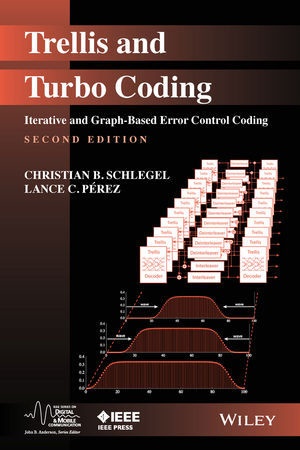Read more
Informationen zum Autor Christian B. Schlegel currently holds the NSERC Industrial Research Chair in Wireless Information Transmission and Networking at Dalhousie University. He holds PhD and MS degrees from the University of Notre Dame. Dr. Schlegel has authored several books including Trellis Coding (1997, IEEE Press) and Trellis and Turbo Coding (2004 Wiley-IEEE). Lance C. Pérez is a Professor, Dean of Graduate Studies, and Associate Vice Chancellor for Academic Affairs at the University of Nebraska-Lincoln. He received his PhD and MS in electrical engineering at the University of Notre Dame. He co-authored Trellis and Turbo Coding ( 2004 Wiley-IEEE Press) with Christian Schlegel. Klappentext This new edition has been extensively revised to reflect the progress in error control coding over the past few years. Over 60% of the material has been completely reworked, and 30% of the material is original.* Convolutional, turbo, and low density parity-check (LDPC) coding and polar codes in a unified framework* Advanced research-related developments such as spatial coupling* A focus on algorithmic and implementation aspects of error control coding Zusammenfassung This new edition has been extensively revised to reflect the progress in error control coding over the past few years. Over 60% of the material has been completely reworked, and 30% of the material is original. Inhaltsverzeichnis 1 Introduction 1 1.1 Modern Digital Communications 1 1.2 The Rise of Digital Communications 4 1.3 Communication Systems 4 1.4 Error Control Coding 7 1.5 Bandwidth, Power, and Complexity 12 1.6 A Brief History - The Drive Towards Capacity 20 2 Communications Basics 27 2.1 The Probabilistic Viewpoint 27 2.2 Vector Communication Channels 29 2.3 Optimum Receivers 31 2.4 Matched Filters 33 2.5 Message Sequences 35 2.6 The Complex Equivalent Baseband Model 39 2.7 Spectral Behavior 44 2.8 Advanced Modulation Methods 46 2.8.1 OFDM 46 2.8.2 Multiple Antenna Channels (MIMO Channels) 48 2.9 A Communications System Case Study 53 2.10 Appendix 2.A 61 3 Trellis-Coded Modulation 67 3.1 An Introductory Example 67 3.2 Construction of Codes 71 3.3 Lattices 80 3.4 Lattice Formulation of Trellis Codes 86 3.5 Rotational Invariance 92 3.6 V.fast 99 3.7 The IEEE 802.3an Standard 101 3.8 Historical Notes 106 4 Trellis Representations 111 4.1 Preliminaries 111 4.2 The Parity-Check Matrix 112 4.3 Parity-Check Trellis Representations 113 4.4 Convolutional Codes and Their Trellis 115 4.5 Minimal Trellises 120 4.6 Minimum-Span Generator Matrices 124 4.7 Systematic Construction of the PC-Trellis 127 4.8 Tail-Biting Trellises 129 4.9 The Minimal Trellis of Convolutional Codes 133 4.10 Fundamental Theorems from Basic Algebra 139 4.11 Systematic Encoders 149 4.12 Maximum Free-Distance Convolutional Codes 151 4.13 The Squaring Construction and the Trellis of Lattices 154 4.14 The Construction of Reed-Muller Codes 161 4.15 A Decoding Example 163 4.16 Polar Codes and Their Relationship to RM Codes 166 Appendix 4.A 171 5 Trellis and Tree Decoding 179 5.1 Background and Introduction 179 5.2 Tree Decoders 181 5.3 The Stack Algorithm 183 5.4 The Fano Algorithm 185 5.5 The M-Algorithm 186 5.6 Maximum Likelihood Decoding 197 5.7 A Posteriori Probability Symbol Decoding 200 5.8 Log-APP and Approximations 207 5.9 Error Analysis and Distance Spectrum 211 5.10 Random Coding Analysis of Optimal Decoding 222 5.11 Random Coding Analysis of Sequential Decoding 232 5.12 Some Final Rema...

